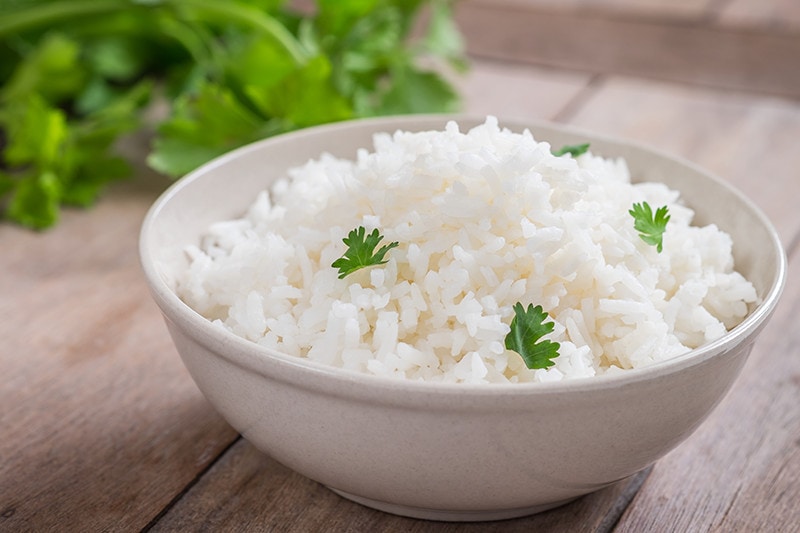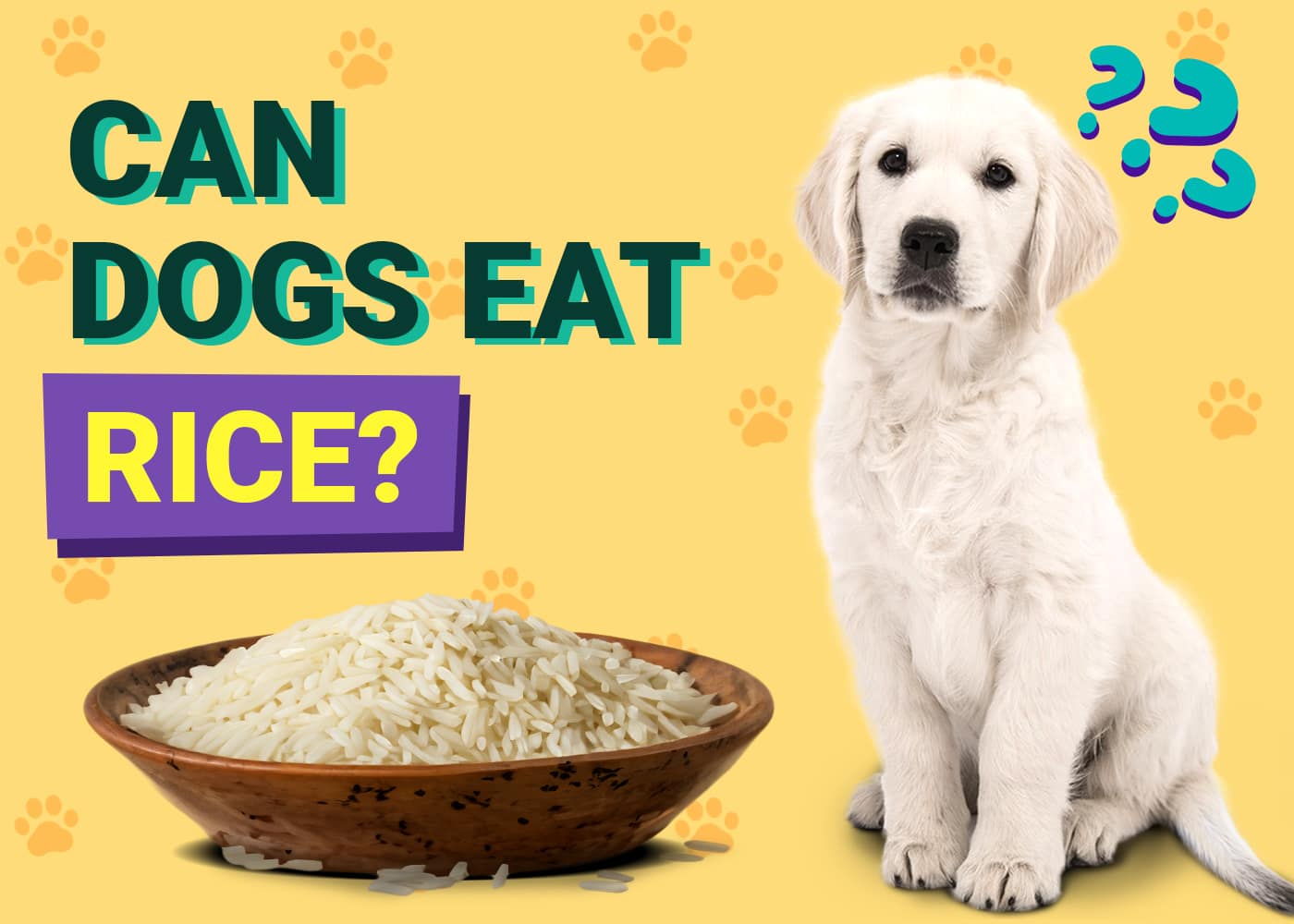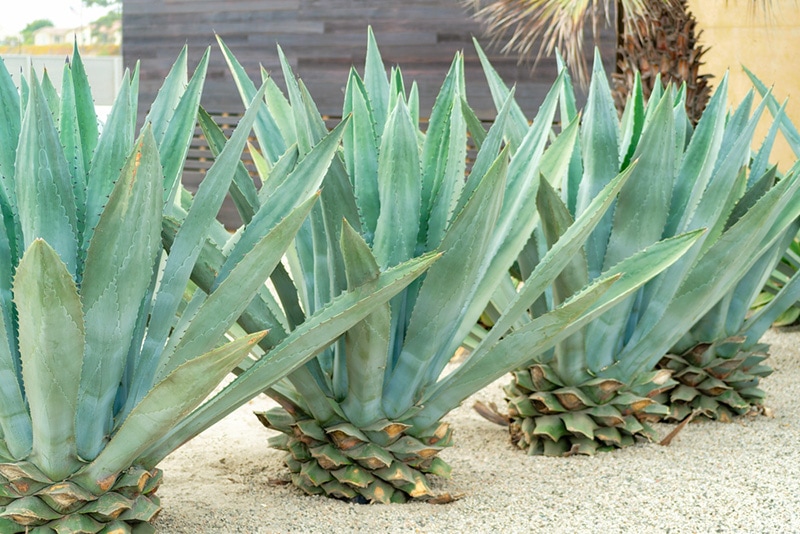Rice is a staple food found in almost every kitchen worldwide, and there are many different varieties to choose from! If your dog is eyeing your rice-based meal, you might wonder if it’s safe for your dog to eat rice.
It’s safe for most dogs to eat small amounts of unseasoned, cooked white rice. It provides various health benefits, though there are a few risks that you should be aware of.
In this article, we discuss what kind of rice is safest for dogs and what you should know before feeding any to your pup.
How Safe Is Rice for Dogs?
Rice isn’t dangerous or toxic to dogs in any way, and as long as it’s cooked, it’s safe for them to eat.
- Magnesium
- Manganese
- Phosphorus
- Iron
- Selenium
- Thiamin
- Vitamin B
- Folic acid
- Niacin
White rice is safe and often recommended by vets as part of a bland diet if your dog is experiencing digestive issues, like diarrhea1.
Rice helps because:
- It’s bland and helps slow stool production and eases diarrhea.
- It’s easier for the body to digest.
- It has starch, which can additionally bind your dog’s stool.
- It contains easily digestible carbohydrates.

The Risks of Rice for Your Dog
Rice has its benefits but there are a few risks. For one thing, only feed your dog rice as an occasional snack. It shouldn’t be given to your dog every day because it does not provide a complete nutrient profile. If your dog is obese or suffers from diabetes1, you’ll want to avoid this, so especially in these cases, speak to your vet before giving rice to your dog2.
Can a Dog Eat Brown Rice?
Brown rice is perfectly safe for dogs to eat. It has a lower glycemic index and is higher in fiber than white rice. Additionally, it has a seed coat (which is stripped to make white rice), and this is what contains most of the nutrients.
While brown rice is healthier than white rice, it’s not always the better choice for dogs. When you need to put your dog on a bland diet for stomach issues, you should only use white rice because brown rice is more difficult for dogs to digest.
But if your dog isn’t suffering from diarrhea or any other stomach upset, brown rice is a healthy addition to a dog’s diet on occasion.

Are Some Dogs Allergic to Rice?
Rice allergies in dogs are rare. The most common food allergies tend to be proteins, especially beef, chicken, and lamb3.
The signs of an allergic reaction to food include diarrhea, vomiting, weight loss, and skin irritation, which includes red patches, hair loss, scratching, scabs, and recurrent ear infections.
If you suspect that your dog has a food allergy, to rice or something else, you should see your vet. They will put your dog on a limited diet to determine which ingredient is the problem. You’ll likely need to avoid purchasing any food for your dog that has this ingredient for the rest of their life.
How to Prepare Rice for Your Dog
If you’re putting your dog on a bland diet, speak to your vet about feeding your dog rice and about any other advice that they have. But the most important thing to remember is that the rice must be cooked and unseasoned. This means no butter, oil, salt, or pepper; some of these additives are bad for dogs. Dogs enjoy rice just fine when it’s plain. For a bland diet, you can also add a small amount of plain, boneless, cooked turkey or chicken.
You’ll want to use two parts rice to one part protein for a dog with ongoing gastrointestinal problems. Speak to your vet if the stomach problems go on for more than 1 or 2 days.

How Much Rice Is Okay for Your Dog to Eat?
When you give rice to your dog, the portions should be small. Rice should be considered a snack, and snacks should only make up 10% of your dog’s diet. The remaining 90% comes from high-quality dog food.
How much rice you should give your dog for treating a gastrointestinal problem will depend on your vet’s instructions. If you just want to give rice to your dog as a treat, it should only be served about two or three times a week in moderation.
- Toy dog (2–20 pounds): 1 to 2 tablespoons
- Example breeds: Chihuahuas, Toy Poodles, Yorkies, and Pomeranians
- Small dog (21–30 pounds): 2 to 3 tablespoons
- Medium dog (31–50 pounds): ¼ cup
- Example breeds: Border Collies, Australian Cattle Dogs, and Basset Hounds
- Large dog (51–90 pounds): 1/3 cup
- Example breeds: German Shepherds, Labrador Retrievers, Australian Shepherds, and Pit Bulls
- Extra-large dog (91 pounds and up): ½ cup
- Example breeds: Bernese Mountain Dogs, Great Danes, Newfoundlands, and St. Bernards
 Final Thoughts
Final Thoughts
Rice is a healthy source of carbohydrates that can make an occasional excellent treat for your dog. White rice is also a great way to treat a dog’s gastrointestinal issues. Regardless of the color, though, rice is a treat, so it should be given to your dog in moderation.
Before you consider adding rice to your dog’s diet, speak to your vet. This goes for anything new that you’re considering adding to their diet, particularly if it’s human food. If you do start adding new food to the menu, you should introduce it quite slowly. The right amount and type of rice might be able to keep your dog healthy and happy.
Related read:
- Can Dogs Eat Rice Krispies? Vet Reviewed Facts & FAQ
- Can Dogs Eat Jasmine Rice? Vet Reviewed Facts & Tips
Featured Image Credit: Dmitriev Mikhail, Shutterstock










